Regional difference in dynamical property of sinoatrial node pacemaking: role of na+ channel current
- PMID: 18390617
- PMCID: PMC2440451
- DOI: 10.1529/biophysj.107.112854
Regional difference in dynamical property of sinoatrial node pacemaking: role of na+ channel current
Abstract
To elucidate the regional differences in sinoatrial node pacemaking mechanisms, we investigated 1), bifurcation structures during current blocks or hyperpolarization of the central and peripheral cells, 2), ionic bases of regional differences in bifurcation structures, and 3), the role of Na(+) channel current (I(Na)) in peripheral cell pacemaking. Bifurcation analyses were performed for mathematical models of the rabbit sinoatrial node central and peripheral cells; equilibrium points, periodic orbits, and their stability were determined as functions of parameters. Structural stability against applications of acetylcholine or electrotonic modulations of the atrium was also evaluated. Blocking L-type Ca(2+) channel current (I(Ca,L)) stabilized equilibrium points and abolished pacemaking in both the center and periphery. Critical acetylcholine concentration and gap junction conductance for pacemaker cessation were higher in the periphery than in the center, being dramatically reduced by blocking I(Na). Under hyperpolarized conditions, blocking I(Na), but not eliminating I(Ca,L), abolished peripheral cell pacemaking. These results suggest that 1), I(Ca,L) is responsible for basal pacemaking in both the central and peripheral cells, 2), the peripheral cell is more robust in withstanding hyperpolarizing loads than the central cell, 3), I(Na) improves the structural stability to hyperpolarizing loads, and 4), I(Na)-dependent pacemaking is possible in hyperpolarized peripheral cells.
Figures





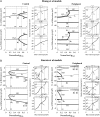
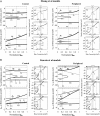


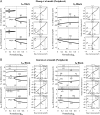




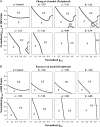
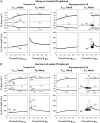


Similar articles
-
Roles of hyperpolarization-activated current If in sinoatrial node pacemaking: insights from bifurcation analysis of mathematical models.Am J Physiol Heart Circ Physiol. 2010 Jun;298(6):H1748-60. doi: 10.1152/ajpheart.00729.2009. Epub 2010 Apr 2. Am J Physiol Heart Circ Physiol. 2010. PMID: 20363885
-
Computational evaluation of the roles of Na+ current, iNa, and cell death in cardiac pacemaking and driving.Am J Physiol Heart Circ Physiol. 2007 Jan;292(1):H165-74. doi: 10.1152/ajpheart.01101.2005. Epub 2006 Jul 28. Am J Physiol Heart Circ Physiol. 2007. PMID: 16877551
-
Roles of L-type Ca2+ and delayed-rectifier K+ currents in sinoatrial node pacemaking: insights from stability and bifurcation analyses of a mathematical model.Am J Physiol Heart Circ Physiol. 2003 Dec;285(6):H2804-19. doi: 10.1152/ajpheart.01050.2002. Epub 2003 Aug 14. Am J Physiol Heart Circ Physiol. 2003. PMID: 12919936
-
Role of pacemaking current in cardiac nodes: insights from a comparative study of sinoatrial node and atrioventricular node.Prog Biophys Mol Biol. 2008 Jan-Apr;96(1-3):294-304. doi: 10.1016/j.pbiomolbio.2007.07.009. Epub 2007 Aug 10. Prog Biophys Mol Biol. 2008. PMID: 17905415 Review.
-
Electrophysiology and pacemaker function of the developing sinoatrial node.Am J Physiol Heart Circ Physiol. 2007 Nov;293(5):H2613-23. doi: 10.1152/ajpheart.00750.2007. Epub 2007 Sep 7. Am J Physiol Heart Circ Physiol. 2007. PMID: 17827259 Review.
Cited by
-
Quantitative Decomposition of Dynamics of Mathematical Cell Models: Method and Application to Ventricular Myocyte Models.PLoS One. 2015 Jun 19;10(6):e0124970. doi: 10.1371/journal.pone.0124970. eCollection 2015. PLoS One. 2015. PMID: 26091413 Free PMC article.
-
Mechanistic links between Na+ channel (SCN5A) mutations and impaired cardiac pacemaking in sick sinus syndrome.Circ Res. 2010 Jul 9;107(1):126-37. doi: 10.1161/CIRCRESAHA.110.219949. Epub 2010 May 6. Circ Res. 2010. PMID: 20448214 Free PMC article.
-
Dynamics of sodium current mediated early afterdepolarizations.Heliyon. 2017 Sep 6;3(9):e00388. doi: 10.1016/j.heliyon.2017.e00388. eCollection 2017 Sep. Heliyon. 2017. PMID: 28924617 Free PMC article.
-
Atrial fibrillation and sinus node dysfunction in human ankyrin-B syndrome: a computational analysis.Am J Physiol Heart Circ Physiol. 2013 May;304(9):H1253-66. doi: 10.1152/ajpheart.00734.2012. Epub 2013 Feb 22. Am J Physiol Heart Circ Physiol. 2013. PMID: 23436330 Free PMC article.
-
Optimization of an In silico Cardiac Cell Model for Proarrhythmia Risk Assessment.Front Physiol. 2017 Aug 23;8:616. doi: 10.3389/fphys.2017.00616. eCollection 2017. Front Physiol. 2017. PMID: 28878692 Free PMC article.
References
-
- Noma, A. 1996. Ionic mechanisms of the cardiac pacemaker potential. Jpn. Heart J. 37:673–682. - PubMed
-
- Kurata, Y., I. Hisatome, S. Imanishi, and T. Shibamoto. 2003. Roles of L-type Ca2+ and delayed-rectifier K+ currents in sinoatrial node pacemaking: insights from stability and bifurcation analyses of a mathematical model. Am. J. Physiol. Heart Circ. Physiol. 285:H2804–H2819. - PubMed
-
- Kodama, I., M. R. Nikmaram, M. R. Boyett, R. Suzuki, H. Honjo, and J. M. Owen. 1997. Regional differences in the role of the Ca2+ and Na+ currents in pacemaker activity in the sinoatrial node. Am. J. Physiol. Heart Circ. Physiol. 272:H2793–H2806. - PubMed
-
- Kreitner, D. 1985. Electrophysiological study of the two main pacemaker mechanisms in the rabbit sinus node. Cardiovasc. Res. 19:304–318. - PubMed
-
- Zhang, H., and M. Vassalle. 2000. Role of dual pacemaker mechanisms in sinoatrial node discharge. J. Biomed. Sci. 7:100–113. - PubMed
Publication types
MeSH terms
Substances
Grants and funding
LinkOut - more resources
Full Text Sources
Miscellaneous

